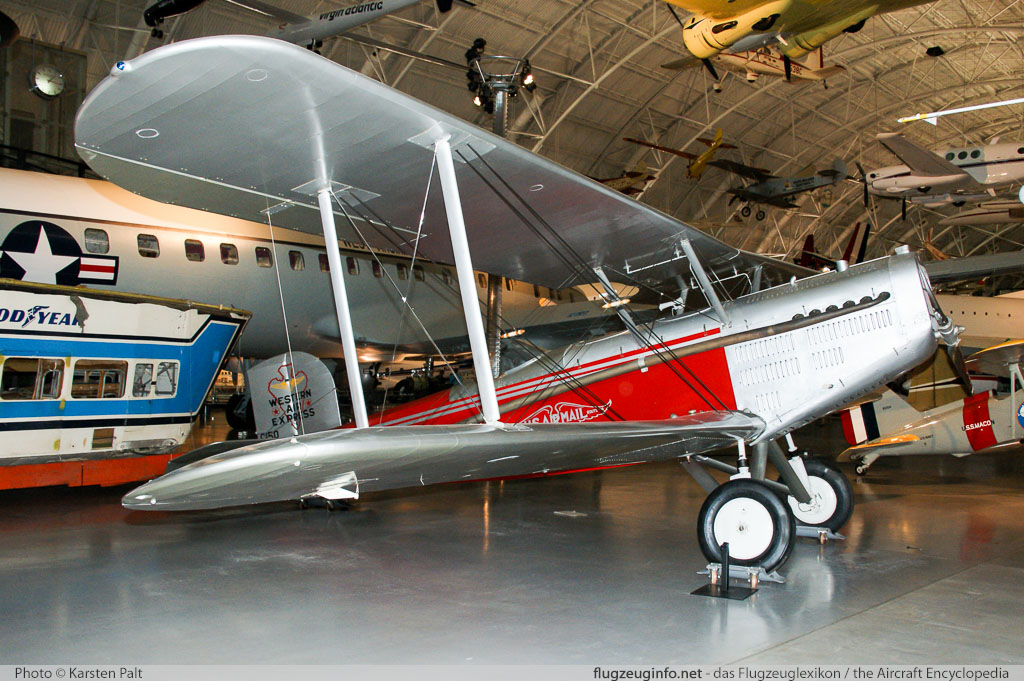
DOUGLAS MAILPLANE SERIES
Western Air Express's interest in the Douglas mailplane series began in October 1925 when this company was awarded Contract Air Mail Four (CAM 4), one of the first mail contracts issued by the Post Office Department pursuant to the 1925 Kelly Air Mail Act. Rebuilt and brought up to M-2 standard, the original Douglas mailplane was redesignated M-1 and was delivered to Western Air Express in June 1926 to supplement its previously ordered fleet of M-2s. However, before expiry of the one-year lease, the DAM-1 was damaged in an accident and returned to Douglas. Proving faster, having longer range, and being capable of lifting two and a half times as much mail as the old DH-4s, the aircraft gave complete satisfaction and its success led to the adoption in March 1926 of the Douglas M-3 as the new Post Office aircraft. aft along the fuselage sides were installed. Operated primarily on the Chicago-Elko (Nevada) segment of the transcontinental air mail route, the DAM-1 was fitted with two 150,000 candle power landing lights under each lower wing tip and two 30,000 candle power parachute flares, and collective exhaust pipes extending well. Soon thereafter the aircraft was handed over to the Post Office Department under a one-year lease agreement.

A fire-proof, aluminum-and-asbestos lined compartment with a capacity of 58.5 cu.ft (l.66 cu.m) was located forward of the cockpit and up to 1,000 lb (454 kg) of mail could be loaded into it through two hatches in the top of the fuselage.Īs could be expected, since it was a direct derivative of the successful O-2, the DAM-1 (c/n 169) successfully passed its manufacturer's trials which began on July 6, 1925, in the hands of Eric Springer. Basically, it was a single-seater with an open cockpit located in the same position as the cockpit of the observer/gunner in the O-2. Sponsored by the Post Office Department and bearing the company's designation DAM-1 (Douglas Air Mail One), the aircraft was virtually identical to the Liberty-powered O-2, but for military equipment and armament and having an entirely revised cockpit arrangement. As the Post Office shared this conviction, negotiations between the Douglas Company and postal authorities led in early 1925 to the development of a specialized mailplane derived from the Douglas O-2. Remarks by Johan Visschedijk: "Donald Douglas followed with interest the progress of, and difficulties experienced by, the US Aerial Mail Service operated by the Post Office Department and believed that a new and more reliable aircraft was needed to replace the modified DH-4s which had operated since 1921. The M-3 had only detailed differences from the M-2. Just before Western Air Express introduced the aircraft into service (in April 1926 from Los Angeles to Salt Lake City), the Post Office ordered 50 aircraft designated M-3 for its major route network. It also had the provision to carry a passenger instead of mail in the front cockpit. The main change from the M-1 was that the tunnel radiator was replaced with a frontal type. When the Contract Air Mail (CAM) routes were introduced, the newly formed Western Air Express Company (later Western Airlines) ordered six mailplanes with the designation M-2. Small modifications were made to the exhaust system to keep fumes away from the pilot and the design was considered a success, but was not ordered into production. The M-1 used the same Liberty engine as the DH.4, which was available in large numbers. The aircraft was designated the DAM-1 (Douglas Air-Mail-One) but this was soon shortened to M-1. The company modified an O-2 by covering over the forward cockpit to make a mail compartment and moving the pilot into what had been the observer's cockpit. In 1925, it decided to modernize and placed an order with Douglas for a replacement aircraft based on the Douglas O-2 observation biplane.

From the internet: The United States Post Office had been running the air mail service since 1918 mainly using variants of the de Havilland DH.4 biplane. This is the very first issue as it has the instructions missing the clear windshield part and NO small additional instruction sheet showing it. The instructions are 'excellent++' and have little yellowing. Decals are in amazing 'near mint' and flat with slight yellowing as the only flaw. Inventoried 100% complete with all parts, decals and instructions present. This classic Jo Kotula artwork kit is molded in deep gloss burgundy and black. It does have very light wear and a light crease at the lower left corner as shown. The box has like-new color and gloss, four solid corners with no repairs, no tags or tape or marks from either, no fading, no missing litho and no tears. 1/48 111-98 Aurora Douglas M2 Mailplane - (M-2)įirst issue dated 1957 and in amazing 'near mint-' investment-grade condition.


 0 kommentar(er)
0 kommentar(er)
